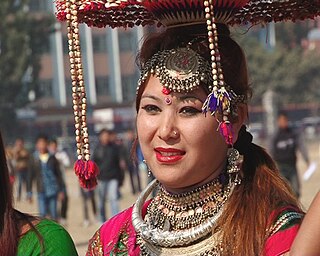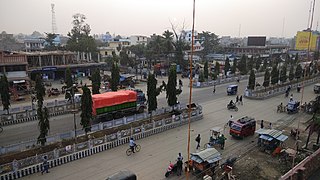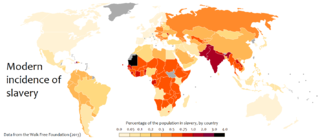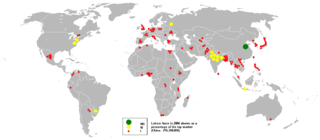Related Research Articles

Debt bondage, also known as debt slavery, bonded labour, or peonage, is the pledge of a person's services as security for the repayment for a debt or other obligation. Where the terms of the repayment are not clearly or reasonably stated, the person who holds the debt has thus some control over the laborer, whose freedom depends on the undefined debt repayment. The services required to repay the debt may be undefined, and the services' duration may be undefined, thus allowing the person supposedly owed the debt to demand services indefinitely. Debt bondage can be passed on from generation to generation.

Anti-Slavery International, founded as the British and Foreign Anti-Slavery Society in 1839, is an international non-governmental organisation, registered charity and advocacy group, based in the United Kingdom. It is the world's oldest international human rights organisation, and works exclusively against slavery and related abuses.

The Tharu people are an ethnic group indigenous to the Terai in southern Nepal and northern India. They speak Tharu languages. They are recognized as an official nationality by the Government of Nepal. In the Indian Terai, they live foremost in Uttarakhand, Uttar Pradesh and Bihar. The Government of India recognizes the Tharu people as a scheduled tribe.

The Terai or Tarai is a lowland region in northern India and southern Nepal that lies south of the outer foothills of the Himalayas, the Sivalik Hills, and north of the Indo-Gangetic Plain. This lowland belt is characterised by tall grasslands, scrub savannah, sal forests and clay rich swamps. In North India, the Terai spreads from the Yamuna River eastward across Haryana, Uttarakhand, Uttar Pradesh, Bihar and West Bengal. The Terai is part of the Terai-Duar savanna and grasslands ecoregion. The corresponding lowland region in West Bengal, Bangladesh, Bhutan and Assam in the Brahmaputra River basin is called 'Dooars'. In Nepal, the term is applied to the part of the country situated north of the Indo-Gangetic Plain. Nepal's Terai stretches over 33,998.8 km2 (13,127.0 sq mi), about 23.1% of Nepal's land area, and lies at an elevation of between 67 and 300 m. The region comprises more than 50 wetlands. North of the Terai rises the Bhabar, a narrow but continuous belt of forest about 8–12 km (5.0–7.5 mi) wide.

GoodWeave International is a network of non-profit organizations dedicated to ending illegal child labour in the rug making industry. Founded in 1994 by children's rights activist and Nobel Peace Prize winner Kailash Satyarthi, it provides a certification program that allows companies that pass inspection to attach a logo certifying that their product is made without child labour. It is an example of a product-oriented multistakeholder governance group.

Siraha District, a district in Madhesh Province, is one of the seventy-seven districts of Nepal. It is situated in the Terai belt of Nepal. The district, with Siraha as its district headquarters, covers an area of 1,188 km2 (459 sq mi). It has population of 637,328 according to census of 2011.The District is bordered with Saptari district in the east, Udayapur districting the north, Bihar state of India in the south and Dhanusa district in the west. Majority of the population here is Yadav, Tharus, Sahs(sahukar), Muslims and ethnic minorities with majority population speaking Maithili language and Nepali language.
Madheshi people is a term used for several ethnic groups living in the central and eastern Terai region of Nepal, constituting 32% of Nepal's population. It has also been used as a political pejorative term by the Pahari people of Nepal to refer to non-pahari people with a non-Nepali language as their mother tongue, regardless of their place of birth or residence. The term Madheshi became a widely recognised name for Nepali citizens with an Indian cultural background only after 1990. Madheshi people comprise various cultural groups such as Hindu caste groups, Muslims, Marwaris, Brahmin and Dalit caste groups, ethnic groups like Maithils, Bhojpuri, Awadhi and Bajjika speaking people and indigenous people of the Terai. Many of these groups share cultural traditions, educational and family ties with people living south of the international border in Bihar, Uttar Pradesh and West Bengal. Tharu people and Pahari people living in the Terai do not consider themselves as Madheshi. In recent times, some politicians and journalists use the term for all Nepali citizens of the Terai.
A Haliya is an agricultural bonded labourer who works on another person's land. The literal meaning of Haliya is "one who ploughs". Haliyas can be found throughout Nepal. But the Haliya system in the far western hilly part of Nepal is considered a bonded labour system.

The early history of slavery in the Indian subcontinent is contested because it depends on the translations of terms such as dasa and dasyu. Greek writer Megasthenes, in his 4th century BCE work Indika, states that slavery was banned within the Maurya Empire, while the multilingual, mid 3rd Century BCE, Edicts of Ashoka independently identify obligations to slaves and hired workers, within the same Empire.
Child Workers in Nepal (CWIN) is a non-governmental organization working as an advocate for children's rights. CWIN supports street children, children subjected to child labour, children who are sexually exploited, and also those victimized by violence. The organization's objective is to protect the rights of children in Nepal. It was established in 1987 by a group of students at Tribhuvan University who, upon investigating the conditions of children living on the streets in Kathmandu, Nepal, recognized the need for advocacy in this area. As a "watchdog" in the field of child rights in Nepal, CWIN acts as a voice for the disadvantaged and exploited children. It does this by lobbying, campaigning, and pressuring the government to protect and promote children's rights, and to end exploitation, abuse and discrimination against children.
The Inner Terai Valleys of Nepal comprise several elongated river valleys in the southern lowland Terai part of the country. These tropical valleys are enclosed by the Himalayan foothills, viz the Mahabharat Range and the Sivalik Hills farther south.

Contemporary slavery, also sometimes known as modern slavery or neo-slavery, refers to institutional slavery that continues to occur in present-day society. Estimates of the number of enslaved people today range from around 38 million to 49.6 million, depending on the method used to form the estimate and the definition of slavery being used. The estimated number of enslaved people is debated, as there is no universally agreed definition of modern slavery; those in slavery are often difficult to identify, and adequate statistics are often not available.

Freeing nearly 13,000 girls from indentured servitude has been a major accomplishment of the Nepal Youth Foundation (NYF), a U.S.-based 501(c)(3) non-profit organization. The mission of NYF is to provide children in Nepal with education, housing, medical and nutritional care, and general support.
Pakistan is a source, transit, and destination country for men, women, and children subjected to trafficking in persons, specifically forced labour and prostitution. The largest human trafficking problem is bonded labour, concentrated in the Sindh and Punjab provinces in agriculture and brick making, and to a lesser extent in mining and carpet-making. Estimates of bonded labour victims, including men, women, and children, vary widely, but are likely well over one million. In extreme scenarios, when labourers speak publicly against abuse, landowners have kidnapped labourers and their family members. U.S. State Department's Office to Monitor and Combat Trafficking in Persons placed the country in "Tier 2 Watchlist" in 2017.
Human trafficking in Nepal is a growing criminal industry affecting multiple other countries beyond Nepal, primarily across Asia and the Middle East. Nepal is mainly a source country for men, women and children subjected to the forced labor and sex trafficking. U.S. State Department's Office to Monitor and Combat Trafficking in Persons placed the country in "Tier 2" in 2017.

Debt bondage in India or Bandhua Mazdoori was legally abolished in 1976 but remains prevalent due to weak enforcement by the government. Bonded labour is a system in which lenders force their borrowers to repay loans through labor. Additionally, these debts often take a large amount of time to pay off and are unreasonably high, propagating a cycle of generational inequality. This is due to the typically high interest rates on the loans given out by employers. Although debt bondage is considered to be a voluntary form of labor, people are forced into this system by social situations.

Backward Society Education (BASE) is a nonprofit non-governmental organization that works with Tharu in Western Nepal to fight illiteracy, bonded labor from the Kamaiya system, and a number of other issues in the region. The group received the 2002 Anti-Slavery Award from the Anti-Slavery International for its work in combating bonded labor, and the Danish International Development Agency reported in 2002, "BASE is running the only literacy campaign in the country." They are currently working on initiatives to help people who have been freed from bonded labor.

An overview of Asian slavery shows it has existed in all regions of Asia throughout its history. Although slavery is now illegal in every Asian country, some forms of it still exist today.

Nepal has a labour force of 16.8-million-workers, the 37th largest in the world as of 2017. Although agriculture makes up only about 28 per cent of Nepal's GDP, it employs more than two-thirds of the workforce. Millions of men work as unskilled labourers in foreign countries, leaving the household, agriculture, and raising of children to women alone. Most of the working-age women are employed in agricultural sector, contributions to which are usually ignored or undervalued in official statistics. Few women who are employed in the formal sectors face discrimination and significant wage gap. Almost half of all children are economically active, half of which are child labourers. Millions of people, men, women and children of both sexes, are employed as bonded labourers, in slavery-like conditions. Trade unions have played a significant role in earning better working conditions and workers' rights, both at the company level and the national government level. Worker-friendly labour laws, endorsed by the labour unions as well as business owners, provide a framework for better working conditions and secure future for the employees, but their implementation is severely lacking in practice. Among the highly educated, there is a significant brain-drain, posing a significant hurdle in fulfilling the demand for skilled workforce in the country.
The haruwa–charuwa system is a forced-labour system based on debt bondage, prevalent in the agricultural sector of the eastern Terai region in Nepal. Haruwa means "forced tiller" and are usually adult males, while charuwa means "forced cattle-herder" and are usually women and children. The victims of this bonded labour system are usually dalit families, most commonly from the Musahar caste. Due to landlessness and poverty, they are forced into service of landowner families under slavery-like conditions. The haruwa–charuwa system is similar to the Haliya and Kamaiya systems of western Nepal.
References
- ↑ Fujikura, T. (2001). "Emancipation of Kamaiyas: Development, Social Movement, and Youth Activism in Post-Jana Andolan Nepal". Himalaya, the Journal of the Association for Nepal and Himalayan Studies. 21 (1): 29–35.
- ↑ Pyakuryal, K.N. (2011). "Emerging from Landlessness, Poverty, and Food Insecurity Circles in Nepal: The Legislative Approach" (PDF). Nepalese Journal of Agricultural Economics 1 (1): 26−36.
- ↑ Regmi, R. R. (1994). "Deforestation and rural society in the Nepalese Terai" (PDF). Occasional Papers in Sociology and Anthropology (4): 72–89.
- 1 2 3 World Organization Against Torture (2006). "The Kamaiya System of Bonded Labour in Nepal" (PDF). A study prepared by the World Organization Against Torture for the International Conference Poverty, Inequality and Violence: is there a human rights response? Geneva, 4–6 October 2005.
- 1 2 "Kamaiya: Slavery and Freedom in Nepal". MS Nepal. Archived from the original on 4 September 2006.
- ↑ "Freed Kamaiyas still live difficult lives a decade after being liberated". nepalnews.com. 18 July 2010. Archived from the original on 23 February 2017. Retrieved 23 February 2016.
- 1 2 Meredith May (8 February 2009). "Olga's Girls". San Francisco Chronicle.
- 1 2 3 4 5 6 7 8 "NYF celebrates Kamlari Freedom Day – 27th June". Nepal Youth Foundation. 30 June 2016. Retrieved 2 November 2018.
- ↑ Pradhan, S. (2006). "Nepal: Land Reforms, Key to Social Harmony". IPS.
- 1 2 3 Mottin, Monica (2018). Rehearsing for Life: Theatre for Social Change in Nepal. Cambridge: Cambridge University Press. p. 166. ISBN 9781108641036 . Retrieved 2 November 2018.
- ↑ Kate Hodal (18 October 2017). "'My dream is coming true': the Nepalese woman who rose from slavery to politics". The Guardian. Retrieved 2 November 2018.